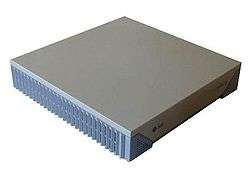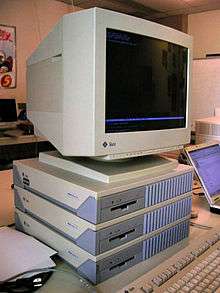SPARCstation 5
SPARCstation 5 or SS5 (code-named Aurora) is a workstation introduced by Sun Microsystems in March 1994. It is based on the sun4m architecture, and is enclosed in a pizza-box chassis. A simplified, cheaper version of the SS5 was released in 1996 as the SPARCstation 4. Sun also marketed these same machines under the "Netra" brand, without framebuffers or keyboards and preconfigured with all the requisite software to be used as web servers.

Specifications
Release Price
Sun rolled out the SPARCstation 5 for under $4000.[1]
CPU support
The SPARCstation 5 may incorporate one of the following processors: 70, 85, or 110 MHz Sun Microsystems microSPARC-II, or a 170 MHz Fujitsu Microelectronics, Inc. (FMI) TurboSPARC. Fujitsu also provided a 160 MHz TurboSPARC CPU Upgrade Kit for upgrading 70, 85 and 110 MHz microSPARC-II models. The SPARCstation 5 has no MBus and thus is limited to use as a single-processor machine.
Memory
The SPARCstation 5 has eight DSIMM slots for memory expansion. Slots can be filled individually with either 8MB or 32MB modules giving a maximum of 256MB memory. The memory used is identical to that of the SPARCstation 4.
Disk drives
The SPARCstation 5 can hold two internal 80-pin SCA, single ended, fast-narrow SCSI drives, a SCSI CD-ROM drive and a floppy. It also supports external SCSI devices. There is no IDE/ATAPI support.
Network support
The SPARCstation 5 comes with an on-board AMD Lance ethernet chipset providing 10BaseT networking as standard and 10Base2 and 10Base5 via an AUI transceiver. A 10/100Mbit/s hme "Happy Meal" NIC can be added for faster connections. The OpenBoot ROM is able to boot from network, using RARP and TFTP. Like all other SPARCstation systems, the SS5 holds system information such as MAC address and serial number in NVRAM. If the battery on this chip dies, then the system will not be able to boot.
AFX
The SPARCstation 5 had three SBus expansion slots which are typical of Sun computer equipment of this era. The third of these shared its expansion backplate and physical space with a special AFX connector which was unique to the SPARCstation 5. Only one card was released for this slot, known as the S24 or TCX. This was a framebuffer that allowed the use of 24-bit colour graphics instead of the eight bit colour of the SBUS CG6 card, also known as the LEGO or low end graphics option. The TCX was also used as the on-board framebuffer of the SPARCstation 4, but this version was less advanced and only supported eight bit colour.
SPARCstation 4
The SPARCstation 4 was introduced in 1995 to provide a lower price point than the SPARCstation 5. Although offered with the same 110 MHz microSPARC-II processor as the SPARCstation 5, it only has one SBus expansion slot instead of three, a single 1.05 GB hard drive, and maximum memory capacity of 160 MB instead of 256 MB. Instead of the built-in audio of the SPARCstation 5, the SPARCstation 4 requires an optional module, installed in its own dedicated slot. The system includes a built-in 8-bit pixel-accelerated graphics adapter, and a new lower-cost 17" monitor was introduced as an option. There is no AFX graphics port.[2]
The SPARCstation 4 has a standard AUI Ethernet connector, unlike the SPARCstation 5 which requires a special cable to mate with a non-standard connector.
SPARC Xterminal 1
Sun used the same enclosure as the SPARCstation 4 for the SPARC Xterminal 1, which was, as the name implies, marketed as an X terminal, with no local storage. Unlike the earlier SPARCclassic X, it did not use the same motherboard as the workstation it was derived from, instead using a lower-powered 50 MHz microSPARC processor and expansion from its base memory of 8 MB to 128 MB rather than 160 MB.[3]
Rather than running Solaris, the SPARC Xterminal 1 and SPARCclassic X loaded and ran special software over the network.
Sun offered an upgrade kit to a full workstation that included a swap to a SPARCstation 4 motherboard, a hard drive and additional memory.
Operating systems

The following operating systems will run on a SPARCstation 5:
- SunOS 4.1.3_U1B onwards
- Solaris 2.3 Edition II to Solaris 9
- Linux - Most distributions of Linux have compatibility issues with TurboSPARC variants
- MirBSD/sparc
- NetBSD/sparc
- OpenBSD/sparc
- NeXTSTEP
- OPENSTEP/Mach
See also
References
- Sun Micro rolls out low-cost workstations
- "SPARCstation 4 Just the Facts". Sun Microsystems. May 1996. Retrieved 2012-06-04.
- "SunFlash 75.04". SunFlash. March 1995. Retrieved 2012-10-11.
External links
- Obsolyte: SPARCstation 5
- Parts List for SPARCstation 5
- "Sun AFX bus speeds graphics", article about the AFX bus and AFX graphics cards in Electronic News